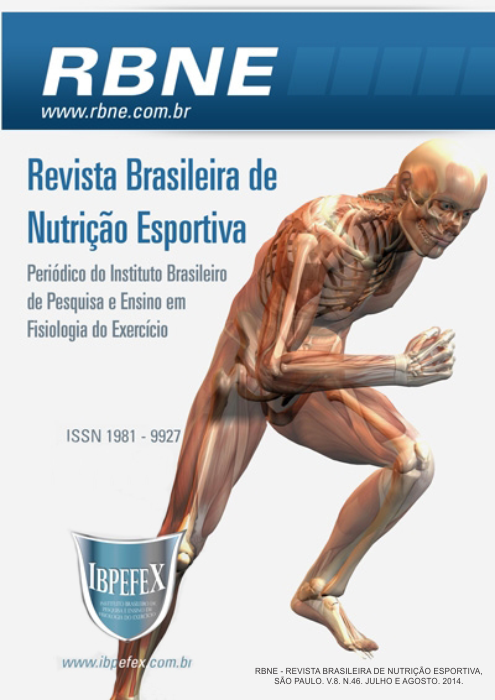Effect of aerobic exercise (swimming) supplementation on muscle and cardiac tissue in rats
Abstract
The aim was to investigate the effect of aerobic physical activity (swimming) supplementation on skeletal and cardiac muscle tissues as well as the influence of supplementation to gain muscle mass by measuring body weight daily. We used male Wistar rats, approximately 60 days kept in individual cages in the vivarium it selffed with balanced feed and water, water for physical activity at room temperature, and charges for execution supplements. The rats were randomly divided into the following groups: G1 controle, G2 control+physical activity without load; G3 physical activity without load+maltodextrin; G4 physical activity without load+creatine G5 physical activity without load+creatine and maltodextrin; G6 control+physical activity load; G7 physical activity load+maltodextrin; G8 physical activity load+creatine; G9 physical activity load+creatine and maltodextrin; concluded that, in the administration of supplements to swimming, there were no significant results in relation to muscle mass, however, there significances for recovery physical strength. Despite these results, there is a need for further studies to prove the use of supplementation in humans.
References
-Andries Junior, O.; Dunder, L. H. Natação: Treinamento fundamentado. Manole, 2002. p. xiii, 3.
-Bean, A. O Guia Completo de Treinamento de Força. Manole.1999. p. 33 e 112.
-Colwin, C. M. Nadando para o século XXI. Manole.2000. p. 157, 159.
-Gomes, R. J.; e colaboradores. Efeitos do treinamento físico sobre o hormônio do crescimento (GH) e fator de crescimento semelhante à insulina (IGF-1) em ratos diabéticos. Rev. bras. Ci. E Mov. Vol. 11. Núm. 3. p.57-62. 2003.
-Ghorayeb, N.; Barros, T. L. N. O Exercício: Preparação Fisiológica, Avaliação Médica, Aspectos Especiais e Preventivos. Atheneu.1999. p. 160.
-Kleiner M. S.; Robinson, M. G. Nutrição para o Treinamento de Força. Manole. 2002. p. 128-130.
-Macardle, W. D.; Katch, F. I.; Katch, V. L. Fisiologia do Exercício: Energia, Nutrição e Desempenho Humano. 4ª edição. Guanabara Koogan. 1998. p. 21, 22.
-Maglischo, E. W. Nadando Ainda Mais Rápido. Manole. 1999. p. 30, 35, 42, 45, 236, 237, 582.
-Medeiros, A.; Oliveira, E. M.; Gianolla, R.; Cassarini, D. E.; Negrão, C. E.; Brum, PC. Swimming training increases cardiac vagal activity and induces cardiac hypertrophy in rats. Braz J. Med Biol Res. Vol. 37. Núm. 12. 2004. p. 1909-1917.
-Pierce, G. N.; Kutryk, M. J.; Dhalla, K. S.; Beamish, R. E.; Dhalla, N. S. Biochemical alterations in heart after exhaustive swimming in rats. J Appl Physiol. Vol. 57. p. 326-331. 1984.
-Rossi, L.; Tirapegui, J. Aspectos Atuais sobre Exercício Físico, Fadiga e Nutrição. Rev. paul. Educ. Fís. Vol. 13. Núm. 1 .p. 67-82. 1999.
-Weineck, J. Treinamento Ideal. 9ª edição Manole, 1999. p. 149, 150, 474, 475.
-Williams, M. H.; Kreider, R. B.; Branch, J. D. Creatina. Manole, 2000. p. 16, 17, 28-29, 31, 34, 43, 198, 199, 223.
-Wilmore, J. H.; Costill, D. L. Fisiologia do Esporte e do Exercício. 2ª edição. Manole.2001. p. 30-33.
Authors who publish in this journal agree to the following terms:
- Authors retain the copyright and grant the journal the right of first publication, with work simultaneously licensed under the Creative Commons Attribution License BY-NC which allows the sharing of the work with acknowledgment of the authorship of the work and initial publication in this journal.
- Authors are authorized to enter into additional contracts separately for non-exclusive distribution of the version of the work published in this journal (eg, publishing in institutional repository or book chapter), with acknowledgment of authorship and initial publication in this journal.
- Authors are allowed and encouraged to post and distribute their work online (eg, in institutional repositories or on their personal page) at any point before or during the editorial process, as this can bring about productive change as well as increase impact and impact. citation of published work (See The Effect of Free Access).






